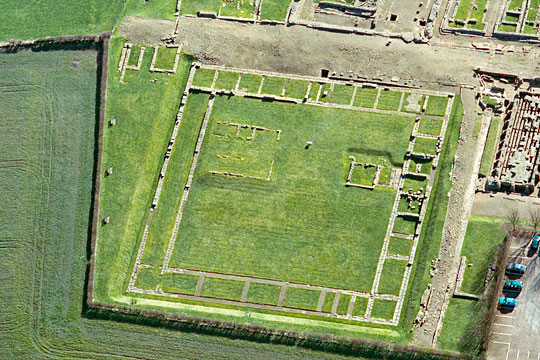Significance of Corbridge Roman Town
The great importance of Corbridge derives from the fact that the site is unencumbered by later development, making extensive excavation possible. The only site with a comparable history in the frontier zone is Carlisle, but there the Roman levels are deeply buried beneath the medieval castle and town.

Stratification
Corbridge is a case study in complex stratigraphic build-up, with four superimposed early forts overlain by a legionary supply base and finally a full-blown civilian town. This sequence illustrates the shift from initial conquest to the consolidation and support of a military frontier (Hadrian's Wall), and finally to the economic development and consolidation of the region, as part of a Roman province with a regular administrative structure of self-governing towns.
Site XI
The construction of the late 2nd-century legionary supply base was on an astonishingly ambitious scale, with the courtyard building, known as Site XI, probably representing the largest single building visible in Roman Britain. As such it has sometimes been identified (probably incorrectly) as an unfinished headquarters building for a legionary fortress or a civic forum-basilica complex.[1] The fact that the building was not completed is stark testimony to the troubled state of the northern frontier in the later 2nd century.
Legionary Compounds
The walled compounds offer an extremely rare visible example of an enclave for legionaries in the midst of a civil town. The only closely comparable, and contemporary, case is at Dura Europos (Syria), a city on the frontier with the Parthian Empire, where one end was walled off to form an enclave for legionary detachments and an auxiliary regiment.
The Collection at Corbridge
The site museum contains a truly remarkable collection of inscribed and sculptured stones. Corbridge has yielded one of the biggest collections of Roman architectural fragments from the north-west provinces, which allows us to visualise the original appearance of the numerous temples (and other buildings) that stood on the site.[2]
The museum also has one of the largest collections of pottery and everyday objects from any site in the Hadrian's Wall area (although much of the excavation pre-dated the practice of recording archaeological contexts, without which it is not always possible to know exactly where on the site the finds came from).
Of special significance are two suits of plate armour found in 1964 buried with many other objects in a box in one of the early forts (most probably the second fort, AD 105–20), collectively known as the Corbridge Hoard. The study of these remains has allowed archaeologists to understand how the classic Roman lorica segmentata plate armour, as depicted on Trajan's Column in Rome, was actually made to work.[3]
Religious Life
Besides giving a plan of the accommodation of legionaries detached to serve on the northern frontier, Corbridge has offered an insight into their religious life. Many pieces of legionary sculpture representing deities from the Roman pantheon were found reused in a 4th-century repair of the main street through the town. In a brilliant study of 1943 Ian Richmond used these pieces to reconstruct the various cults of which the legionaries at Corbridge were devotees.[4]
READ MORE ABOUT CORBRIDGE ROMAN TOWN
Footnotes
1. The debate is traced in N Hodgson, 'The development of the Roman site at Corbridge from the first to third centuries AD', Archaeologia Aeliana, 5th series, 37 (2008), 47–92, esp. 63–5.
2. N Hodgson, 'Roman architectural fragments at Corbridge: a survey and study', Arbeia Journal, 9 (2010), 1–42.
3. L Allason-Jones and MC Bishop, Excavations at Roman Corbridge: The Hoard (London, 1988).
4. IA Richmond, 'Roman legionaries at Corbridge, their supply-base, temples and religious cults', Archaeologia Aeliana, 4th series, 21 (1943), 127–224.